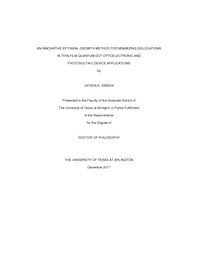
ATTENTION: The works hosted here are being migrated to a new repository that will consolidate resources, improve discoverability, and better show UTA's research impact on the global community. We will update authors as the migration progresses. Please see MavMatrix for more information.
Show simple item record
| dc.contributor.author | Gandhi, Jateen | en_US |
| dc.date.accessioned | 2012-07-25T19:09:53Z | |
| dc.date.available | 2012-07-25T19:09:53Z | |
| dc.date.issued | 2012-07-25 | |
| dc.date.submitted | January 2011 | en_US |
| dc.identifier.other | DISS-11552 | en_US |
| dc.identifier.uri | http://hdl.handle.net/10106/11104 | |
| dc.description.abstract | A new buffer layer method for epitaxial growth of lattice-mismatched semiconductor quantum-dots based p-i-n structures is presented. To our knowledge this is the first instance of a dislocation-reduction approach that has shown reduced dark current behavior in a quantumdot device compared to its counterpart homojunction p-n device consisted of the barrier material. The present work compared a lattice misfit strain build-up behavior between an In0.15Ga0.85As (p) / InAs (i) / In0.15Ga0.85As (n) (QD) device to an In0.15Ga0.85As (p) / In0.15Ga0.85As (n) (HOM) device, as both were grown on an un-doped gallium arsenide (GaAs) (100) substrate. The intrinsic region of QD device incorporated 5 layers of 2.1 ML indium arsenide quantum dots that were fabricated using self-assembly via Stranski-Krastanov strain release mechanism. Atomic force microscopy measurements exhibited 35 ± 3 nm sized pyramidal islands with a narrow distribution and a density of 2.5 x 1010 per cm2. A low temperature (6K) photoluminescence characterization of the QD sample revealed an activity at 1400 nm wavelength that was attributed to optical pumping of carriers, which experienced a 3- dimensional quantum confinement due to a potential well formed by In0.15Ga0.85As matrix, and their subsequent radiative recombination. Both of the QD and HOM samples were characterized using x-ray diffractometer (XRD) and a high resolution transmission electron microscopy (HRTEM) method. The XRD data recorded a signature of the biaxially strained pseudomorphic section of In0.15Ga0.85As buffer layer that absorbed a lattice misfit due to epitaxial growth on GaAs substrate. This signature consisted of a set of twin peaks at higher and lower 2θ degrees resembling elastically strained and plastically relaxed sections, respectively, of the buffer layer residing in the vicinity of buffer-GaAs interface. A comparison of those peaks between QD and HOM samples exhibited an increase in the volume of the plastically relaxed region in HOM sample and a cross-sectional HRTEM image revealed absence of dislocations within the intrinsic region of QD sample. A current-voltage characterization using a four-probe tool recorded lower dark current from the QD device compared to HOM that, along with XRD and HRTEM results, confirmed an enhanced elastic absorption of the lattice misfit in the QD device. The buffer layer method is advantageous in the field of epitaxial growth due to the virtues of simplicity, efficient device fabrication, improved thermal stress performance and easier strain build-up management. | en_US |
| dc.description.sponsorship | Kim, Choong-Un | en_US |
| dc.language.iso | en | en_US |
| dc.publisher | Materials Science & Engineering | en_US |
| dc.title | An Innovative Epitaxial Growth Method For Minimizing Dislocations In Thin-film Quantum-dot Optoelectronic And Photovoltaic Device Applications | en_US |
| dc.type | Ph.D. | en_US |
| dc.contributor.committeeChair | Kim, Choong-Un | en_US |
| dc.degree.department | Materials Science & Engineering | en_US |
| dc.degree.discipline | Materials Science & Engineering | en_US |
| dc.degree.grantor | University of Texas at Arlington | en_US |
| dc.degree.level | doctoral | en_US |
| dc.degree.name | Ph.D. | en_US |
Files in this item
- Name:
- Gandhi_uta_2502D_11552.pdf
- Size:
- 4.012Mb
- Format:
- PDF
This item appears in the following Collection(s)
Show simple item record


